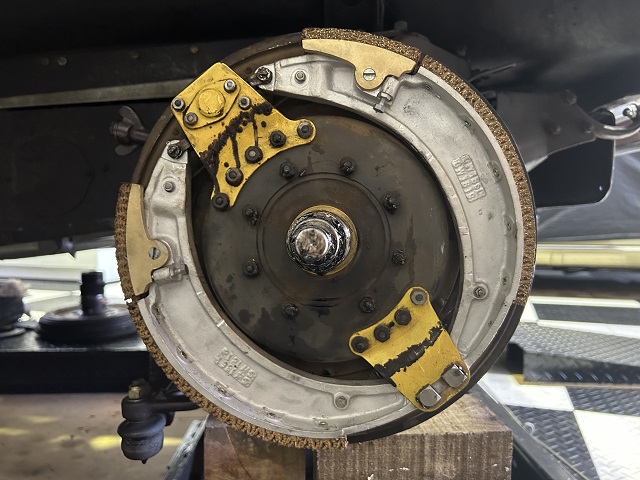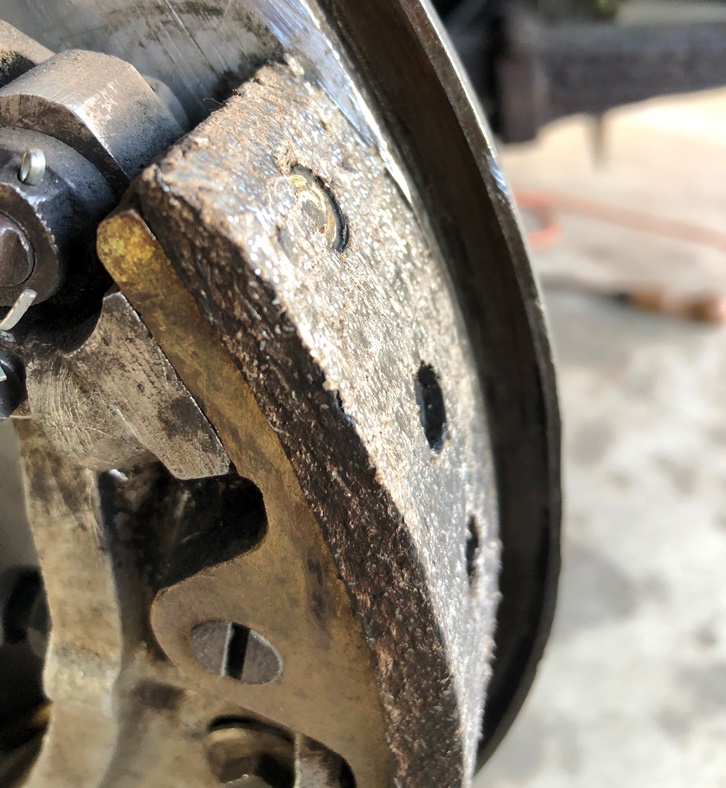| Author | Message | ||
John Rowney Experienced User Username: johnrowney Post Number: 176 Registered: 02-2015 |
My 1938 Wraith, WXA68, had a FTP at Sawtell on the way home from a fabulous 20-Ghost Club tour of Tasmania a couple of weeks ago. The problem was in the front left brake drum, which I will probably describe in detail at a later date in Praeclarum. Anyway, I am fixing everything which was a problem, and I have decided to reline the brake shoes, since the thinnest part of the lining was only 1.2 mm above the rivet. Does anyone know what the original thickness of the brake lining material should be? I cannot find any reference anywhere. I relined the back shoes 9 years ago and everything with them worked well, but I have no records of the lining thickness used. Obviously, with modern techniques, I won't have rivets to be worried about, so the same thickness of the lining I have now will serve WXA68 for many more years. | ||
Koen Dierckxsens New User Username: prewarrb Post Number: 8 Registered: 04-2024 |
John, for prewar Wraith, the full original thickness of new brake linings on main and auxiliary shoes would have been .375inch. If you have still a reasonable amount of lining left (1.2mm above rivets), then it may be advisable to think twice before renewal. Indeed. 1. these linings do wear VERY slowly - check this with your annual mileage, you may have enough for the next 10 years ? 2. linings that are well bedded in, give best braking performance 3. it is not uncommon for relining of prewar RR-brakes to generate undesired consequences, poor braking performance, brake judder, etc... For a decent job you will need a circumferential cutter, use correct lining material (not too hard, not too soft), to name but a few issues... Good luck! Koen, | ||
John Rowney Experienced User Username: johnrowney Post Number: 177 Registered: 02-2015 |
Thanks, Koen I had the same sort of thoughts about leaving things as they are, but friends suggested that I reline the brakes since I had everything off. I will be doing about 5000 miles per year for the next couple of years if all our plans work out, so I am still uncertain about how long the 1.2 mm clearance will last. The guy who is going to do the relining went on holidays the day after I dropped the shoes into the workshop, and so I won't be able to get them relined for a couple of weeks. Next week I will go back to the brake workshop and measure the overall thickness of the linings. Perhaps this will tell me something regarding the original 0.375 inch lining thickness. This is the first time I have ever seen an estimation of the original lining thickness, so I look forward to seeing how much may have been worn from the front brakes - probably over 40 years of driving since the car was rebuilt. In my memory, I think that the thickness of the existing lining was less than 1/4". However, nothing is better that a real measurement using a vernier. I will keep everyone informed when I get an accurate measurement. | ||
Koen Dierckxsens New User Username: prewarrb Post Number: 9 Registered: 04-2024 |
John, I have given you original thickness for new linings before riveting to the shoes. It may well be clear that after mounting the whole lot on a car and passing with a circumferential cutter, the final thickness for new linings on a car may have been less ! Thx for feedback, that is very instructive here. Regards, Koen, | ||
John Rowney Experienced User Username: johnrowney Post Number: 179 Registered: 02-2015 |
Hi Koen I finally got to the brake workshop and did a few measurements of the existing brake linings. They ranged from 8.3 mm down to a low of 4.4 mm. Compared to your original of 0.375", which is around 9.5 mm, it would look like the 0.375" would probably have been my original thickness. The huge differences in wear is a little hard to understand except that the areas of most wear are on the small noise reducing parts of the shoes. It will be a couple of weeks before the guy who does the work gets back from holiday. I will let you know what happens and what he thinks and does. | ||
John Rowney Experienced User Username: johnrowney Post Number: 184 Registered: 02-2015 |
I got my relined brake shoes back from the brake specialists today. The linings were rivetted on the old-fashioned way, and the linings had a quite rough appearance. The thickness of the lining, due to the roughness had a range of about 8.6 to 9.1 mm, which is close to Koen's 0.375". I am currently fitting the shoes, but I am waiting on an engineering shop to fabricate some replacement bolts and nut retainers before the car will be back on the road. Apparently, the job to reline the brake shoes was difficult, and the brake expert who did the job doesn't want to see me back with any more jobs like that! | ||
Koen Dierckxsens New User Username: prewarrb Post Number: 10 Registered: 04-2024 |
John, thx for update ! Before mounting the shoes, make sure there is a small chamfer on the biting edges of the linings, in order to prevent "brake judder", - but I guess you will know that. Please keep us posted ! Regards, Koen, | ||
John Rowney Experienced User Username: johnrowney Post Number: 185 Registered: 02-2015 |
Koen. I was completely unaware of the need for a chamfer on the linings. Many thanks for your advice. Since reading your post, I have looked at chamfers for brake shoes on the net, and there seems to be lots of divergent opinions regarding where the chamfers should be. With my Wraith, there are two separate brake linings on each section - a short "noise reduction" section and a main section on each shoe.  This is the drivers side front brake showing 2 sections on each shoe. For this braking system the wheel rotates in the clockwise direction. With the two small linings and the two large linings, which edges should I file the chamfers? I didn't put any chamfers on the rear brake shoes when I got them relined 9 years ago, but I can't remember whether the brake company put chamfers on them then, and I didn't take photos. I did have judders in the brakes a few years ago, but I replaced the servo linings and that removed the problems. As a relatively newcomer to old cars, I appreciate any help I can get. John | ||
Koen Dierckxsens New User Username: prewarrb Post Number: 11 Registered: 04-2024 |
John, because most parts of our cars are no longer new, these vehicles are prone to brake judder. In addition, the risk for brake judder is always greater with the front drum brakes than with the rear ones. You can probably assemble the parts like this, without chamfers, and no vibrations will occur - it is possible. However, due to the risk of judder, I suggest doing so and chamfer the leading edges.  If wheel is turning clockwise, I suggest starting with a chamfer arrow 1 (2 spots). If still judder would appear (driving test), you could attack the spots arrow 2. These chamfers on the leading edges will reduce risk for judder when braking forward. If you want to reduce the risk for judder when reversing the car and then braking, you could als chamfer the trailing edges. IMHO this will not be necessary as reverse braking forces are always less "heavy", is it not ? Please find below picture of a friend experiencing serious brake judder before. He did only chamfer my top arrow 1 - problem solved.  I do agree, this chamfer seems to be a little "comprehensive", but it did do the job  Good luck ! (And please, let us know how your brakes do perform) Koen, | ||
John Rowney Experienced User Username: johnrowney Post Number: 186 Registered: 02-2015 |
Thanks for all that great information, Koen. I have now done all the chamfering at both the 1 and 2 positions. Now all I have to do is wait until some bits and pieces get fabricated. I was hoping to go to the RROCA National Rally in a week's time in the Wraith, but the engineering business doing the work is behind schedule, so things might have to wait until June. | ||
John Rowney Experienced User Username: johnrowney Post Number: 187 Registered: 02-2015 |
I actually got all the bits I needed in time, and had the car prepared the night before we headed off. The brakes were noisy at times for the first kilometre or so, then settled down. By the time I reached Newcastle, the brakes bedded in quite well - so well in fact that the front brakes weren't effective. I adjusted the brakes in Newcastle and they were OK for the trip home. I have a little bit of a pull to the left, but when I get the car on the hoist soon, I should be able to balance the adjustment far easier than in the dreadful parking area at the hotel in Newcastle. | ||
David Hughes Experienced User Username: wedcar Post Number: 182 Registered: 07-2004 |
John Great to see the car there, looking splendid, in Newcastle. Regards David |